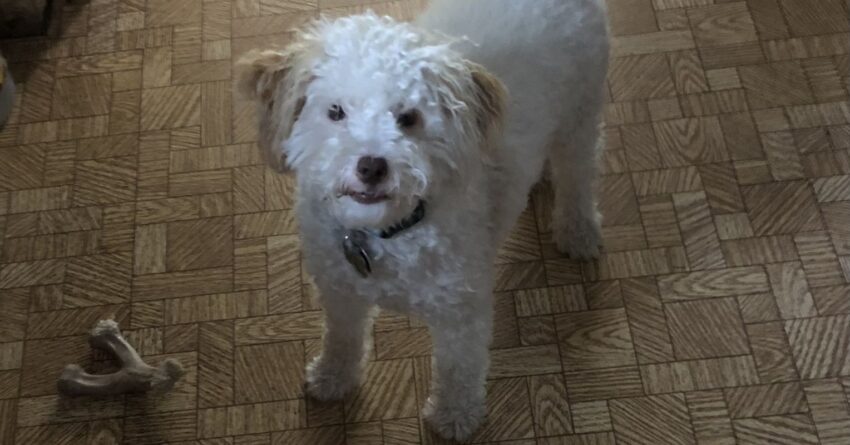
Harry, the Anxious ADHD Dog
Source: Deirdre V. Lovecky
This is Part 2 in a series about examining ADHD-like behavior in dogs. Read Part 1 here.
Some breeds of dogs show ADHD-like behaviors. Also, many dogs exhibit anxiety and these conditions can overlap (Tiira et al., 2016; Salonen et al., 2020). In determining if a dog has true ADHD, it is necessary to discriminate whether the dog shows behavior typical of the breed, has severe anxiety, or has been subject to environmental factors that can produce these behaviors.
Rating scales and other methods of assessment can help determine canine ADHD. Validated and reliable scales measuring personality, inattention, hyperactivity, and impulsivity are available. What follows is a description of the scales and how my dog, Harry, did on each.
The Canine Behavioral Assessment and Research Questionnaire (C-BARQ) (Hsu & Serpell, 2003). This scale has been widely used to track behavior changes over time in shelter dogs and to define characteristics of different breeds. It looks at factors such as aggression, anxiety and fear, attachment and attention-seeking behaviors, predatory chasing, excitability, energy, trainability, and problem behaviors (Bohland et al., 2023). There is an online version available to dog owners.
On the C-BARQ, Harry scored as less aggressive with both people and dogs than average. He was, however, much more fearful of people and unexpected noises and sights, with more separation issues. He was less trainable and more excitable and energetic than average. Thus, Harry shows many problems related to fearfulness and anxiety as well as ADHD symptoms (excitability, difficulty with training and high energy).
ADHD Questionnaires
Questionnaires that rate ADHD in dogs are experimental, and while there were control groups of dogs with and without ADHD, there were no control groups of dogs with high levels of anxiety or ADHD with anxiety. Thus, dogs high in anxiety might score high on ADHD scales.
The Dog ADHD Rating Scale Owner Version (Vas et al., 2007) measures inattention and hyperactivity/impulsivity. Replication in France found the scale discriminated between dogs diagnosed with ADHD and those without it (Marlois et al., 2022).
On the refined scale and norms developed by Marlois and colleagues (2022), Harry scored at or above the scores of the dogs in their ADHD sample for Total Score, Inattentive Score, and both of their Hyperactivity/Impulsivity Scales.
The Lincoln Scales
Several useful rating scales were developed by the University of Lincoln in the U.K. These free scales developed for dog behavioral experts can be found here.
The Dog Impulsivity Assessment Scale (DIAS) (Wright, Mills & Pollux, 2011) measures impulsivity in three categories (Behavioral Regulation, Aggression/Response to Novelty, and Responsiveness), allowing dogs to be rated in each category as well as for overall impulsivity.
On the DIAS, Harry scored beyond the normal range for total score and behavioral regulation. For the aggression/reaction to novelty scale he was in the normal range and on the responsiveness scale, he was just below the normal range. Thus, much of Harry’s score for impulsivity was due to his lack of behavioral regulation.
The Lincoln Sound Sensitivity Scale (Mills et al., 2013) and Lincoln Canine Anxiety Scale (Mills et al., 2020) evaluate how a dog reacts to specific stimuli, for example, fireworks, veterinary visits, etc. Both intensity as well as frequency of the fearful response can be measured. Over time, results of treatment can be charted.
On these scales, Harry was sensitive to some sounds but not the ones usually associated with sound sensitivity such as thunder and fireworks. He was reactive to phones, beeping noises, and sometimes the refrigerator or heating system going on. When he reacts, it is very intense with much barking and running. He was also significant for fear of objects, having his harness put on, meeting new people, going in the car, suddenly seeing new things, going on vet visits, and grooming. He also still acts afraid of me at times.
The Positive and Negative Activation Scale for Dogs (Sheppard & Mills, 2002) measures temperamental fearfulness (negative activation) and responsiveness to rewards (positive activation). For the negative scale, scores higher than the normal range suggest a fearful temperament. For the positive scale, scores below average may indicate depression and above average, high levels of sensation seeking or hyperactivity. The positive scale is further subdivided into three subscales: energy and interest; persistence; and excitement.
Harry scored much higher than the average range for the negative activation scale, suggesting he is temperamentally fearful. He also scored above the range for positive activation, particularly for the persistence subcategory. This suggests that he is temperamentally sensation-seeking, hyperactive, and persists in negative behaviors.
Other Methods of Assessment
Training Focus Clicker Test. This is a continuous reinforcement test in which the dog is first given treats at an exceptionally high rate, then at a lower frequency, then with varying intervals and finally after short break. If the dog can maintain attention for the 10 minutes of the test, it probably does not have ADHD (Miller, 2023).
Harry riveted his attention on the bowl with the treats, even though it was not at his eye level. He quickly learned that a click meant a treat. He was able to sit for the clicker and to look at me very briefly. He was able to delay getting a treat. Thus, he passed the clicker test, except for looking, not at me but at the treat bowl. So, if he hyperfocused on the treats, did he actually pass? It’s hard to say. Certainly, hyperactive children can hyperfocus on items of great interest. Put to the test, out on the street, Harry has little attention even for the clicker.
The Stimulant Challenge. This test is done with your veterinarian administering a low dose of methylphenidate (0.2mg/kg) or dextroamphetamine (0.2mg/kg) after measuring the dog’s heart rate, respiration, and motor activity. About 30 to 90 minutes later, if heart rate and motor activity decrease by at least 15%, the dog likely has ADHD (Stiles et al., 2011). Because Harry is a small dog with a low body weight, there is a danger of toxicity at even low doses of stimulant, so I decided to forego this test for now.
Does Harry Have ADHD?
Harry is now 19 months old. He has gotten somewhat better with a routine, lots of exercise, behavioral training, and a carefully selected diet including probiotics. When given a homeopathic anti-anxiety medication, Harry became calmer and less noise-sensitive. He was more able to tolerate sudden movement and new things. He, however, still exhibited the ADHD symptoms of hyperactivity, impulsivity, and poor attention, especially in poor trainability, impatience, barking, lunging, jumping, and over-reactivity to even familiar people and dogs.
Harry scored in the problem range on the owner-rated questionnaires for ADHD behaviors, but he also scored in the problematic range on anxious and fearful behaviors. In his exuberance and energy, his inability to calm down once excited, and his poor trainability, he is unlike most miniature poodles and more like dogs with ADHD. In addition, he is very much a dog who is fearful of many things and people. It is likely that Harry has both anxiety and ADHD.
A dog is the only thing on earth that loves you more than he loves himself.”
― Josh Billings
Copyright Deirdre V. Lovecky.
